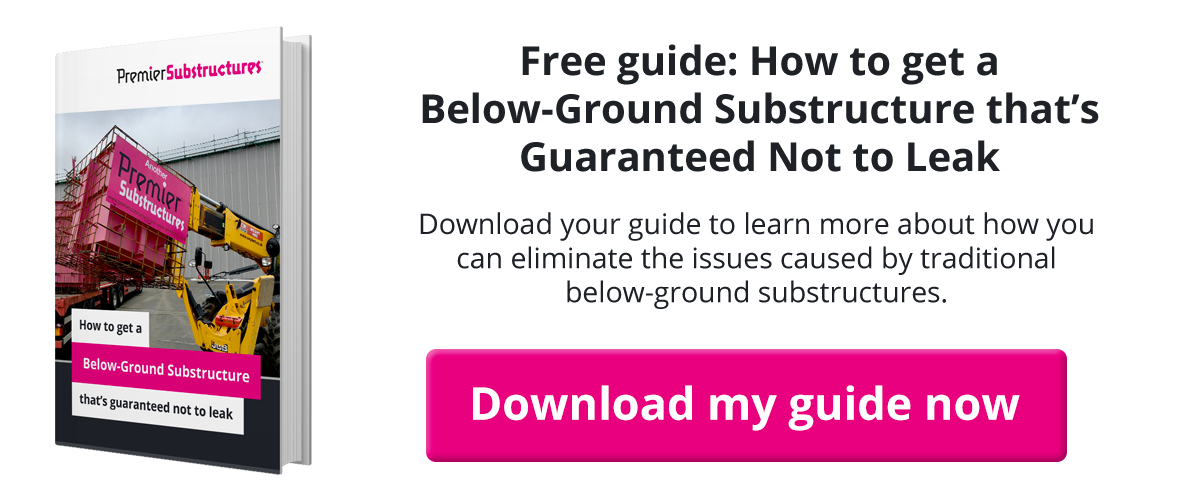Curious about the best way to construct a lift pit for your next project?
Having a reliable lift system in place is a must for any modern building – for if it fails, it can cause chaos with your lift grinding to a swift halt and being out of service for potentially weeks at a time.
That’s why choosing a reliable method of below-ground construction that’s completely watertight – without too much risk for your project – is absolutely essential.
However, with below-ground construction, this is unfortunately not always a given. In fact, traditional below-ground construction methods (like in situ concrete) are known to leak over time, which will cause problems later down the line.
But wait – would you believe me if I told you there was another option?
As a subcontractor who specialises exclusively in prefabricated steel, I’m going to tell you more about the differences between in situ and prefabricated steel lift pits.
Constructing a lift pit using in situ concrete
You’ve probably already been looking at in situ for your lift pit. In fact, it may already be how your project’s been specified. After all, it’s the most common below-ground construction method available, having been used for over 100 years.
But just because it’s been around a long time, doesn’t necessarily mean it’s the best method to use. It’s actually very tricky and challenging to construct below-ground this way. And the product that you’re left with at the end of the day may not be the best.
In fact, it may be built to low tolerances, and prone to leak over time due to the fact that cracks tend to form during the construction and curing process.
There’s also the risk of unskilled labour, as operatives must enter the excavation in order to complete the works. Not to mention weather the UK is famous for, and the logistics involved in completing the job and transporting the materials.
Okay, okay… in situ may still be the best option if your substructure has to cover a large area.
But if not? Well, there is another option…
Constructing a lift pit using prefabricated steel
“Wait a minute… prefabricated steel? What’s that?” — I hear you ask.
Well, I’ll tell you.
Prefabricated steel is an innovative, much newer method of below-ground construction. It involves manufacturing a substructure – almost any kind of substructure, lift pits included – entirely out of steel, off-site in a monitored factory environment, with strict quality control.
The result is a far superior substructure that won’t leak or crack. It’s constructed in a way that’s similar to the hull of a ship. The steel plates are welded together, meaning no water can get in. Therefore, you can be confident your lift pit will stand the test of time.
A prefabricated steel lift pit can also last over 100 years in the ground – despite being exposed to the most acidic ground conditions. But that’s not all – another huge benefit is that it can be installed 70 – 80% faster than in situ concrete.
So, if you need your lift pit installed quickly – and have around at least six weeks’ in advance to order – then prefabricated steel can be a fantastic option.
Finally, prefabricated steel lift pits are built to very, very high tolerances (+-3mm). This means lower maintenance costs over the long-term.
TIP: Want to know more about steel prefabrication? Read my recent blog: ‘What is Steel Prefabrication Below-Ground and How Does it Work?’.
Advice from a specialist subcontractor
We’re currently the only ones offering prefabricated steel as a method of below-ground construction, and people tend to be wary of the new and unknown.
Mostly all lift pits are made from in situ, although there are more and more precast options coming up for lifts, due to the speed it can save on-site. Prefabricated steel is the next, much better step that takes you away from relying on concrete – which cracks and leaks.
If you think this option could be the best course for you, I’d urge you to give us a call to discuss your options and learn more about whether prefabricated steel is a good fit for your specific project.
Conclusion
Thanks for reading, and hopefully this article has managed to shed some light on how these two very different methods compare when constructing your lift pit.
If you think you might like to learn more about whether prefabricated steel might be a good option for your lift pit, get in touch with us today – we’re happy to listen, and offer a completely bespoke service.

